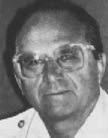Diagnose or Die
In an effort to build up their management, marketing, and treatment procedures, many orthodontists are neglecting the cornerstone of the building, which is diagnosis.
A great many orthodontists make their diagnosis at the chair at the initial examination. Some confirm this with diagnostic records. Some do not. This might be a workable procedure if diagnoses are made on the basis of the Angle classification, and all one is concerned with is a dental diagnosis. The inadequacy of the Angle classification as a diagnostic tool was made very clear in Dr. McNamara's paper in the July 1981 issue of Angle Orthodontist. Not only were there 243 different Class II categories, but no one group constituted as much as 10% of the total sample; and, most importantly, the majority of the Class II sample had neutral or retrusive maxillas, not protrusive maxillas as is generally believed. If that is the case, what justification can there be to place a headgear on all Class II cases, or a functional appliance with a significant headgear effect, before determining which Class II one is dealing with?
The Angle classification essentially describes a molar relationship, which itself can be rendered inaccurate if one fails to take into account the drift of teeth into space created by extraction or missing teeth. Considering all the factors that contribute to malocclusions, as Dr. Enlow was discussing in JCO in October, it is totally inadequate to try to use a dental classification to describe a malocclusion and to consider that to be a diagnosis.
Cephalometrics is useful, if you recognize its shortcomings. Cephalometric analysis has not yet shaken off the problems it had when Sassouni and Krogman published their monumental work in 1957. They submitted what we would call a Class II case to 44 different analyses, including some still familiar names--Downs, Steiner, Tweed, Northwestern, Bjork, Coben--in the form they had at that time. Those analyses that used Frankfort horizontal as the reference plane generally found the maxilla to be protrusive and the mandible normal. Those that used SNa as the reference plane generally found the maxilla to be normal and the mandible retrusive. Sassouni and Krogman hoped for some standardization in the choice of points and planes, which has not come to pass. Several investigators, including McNamara, continue to find different diagnostic information coming from different cephalometric analyses. However, the basis for the problem probably still is the one that Sassouni and Krogman pinpointed 25 years ago in the choice between SNa and FH.
Perhaps we will find some resolution to the problem in a more biologic or functional diagnostic method or with the development of superior cephalometric methods, with the translation of the image of the head to the computer in three dimensions. The interactive use of computers, with the orthodontist digitizing the skeleton and soft tissue and building in a variety of choices for growth, treatment, and analysis, and recent advances in muscle physiology offer new and fascinating possibilities for a better approach to orthodontic diagnosis. Whatever else the orthodontist may delegate, diagnosis is one function he cannot and should not delegate. It is one of the key areas he must spend his time in--and probably more time than the average orthodontist has been spending with more simplistic approaches.
A companion, disturbing element in diagnosis is the subtle advocacy of what Dr. Ackerman called a therapeutic diagnosis--diagnosis through treatment. If it works, you were right; if it doesn't, try something else. Even if you are an SNa person and the FH people think you are wrong, you can adjust your diagnosis to the conditions that exist and not have many cases that defy diagnosis--provided you really make a diagnosis. Most cases in an orthodontic office can be diagnosed and treated according to that diagnosis, without rediagnosing the case at each visit and asking yourself, "What will we do today?" That does not mean that you ought to follow a blind prescription. You are looking at the case each time, but the vast majority of growing people do grow within a fairly narrow range, and those whose growth is completed are that much easier to diagnose.
One of the worst approaches to the practice of orthodontics has been for the orthodontist to downgrade the diagnosis--to make it in five minutes of clinical examination and give it away at that time. It makes the diagnosis seem trivial, even generic. But, worse than that, it misleads the orthodontist himself into thinking that's all there is to it. The orthodontist who appreciates the importance of the diagnosis and who impresses its importance on his patients, and who demonstrates that he is thorough in studying the patient's problem and possible solutions, will not only be offering a better service, but is likely to achieve better treatment results and a perception of difference in the minds of the public between his practice and the other less thorough practices.
Diagnosis is the most "doctoral" thing we do in orthodontics. If we do not give it the attention and the importance that it deserves, we ourselves will be responsible for a public image of orthodontics as mechanistic, narrow, and replaceable with less expensive services.



